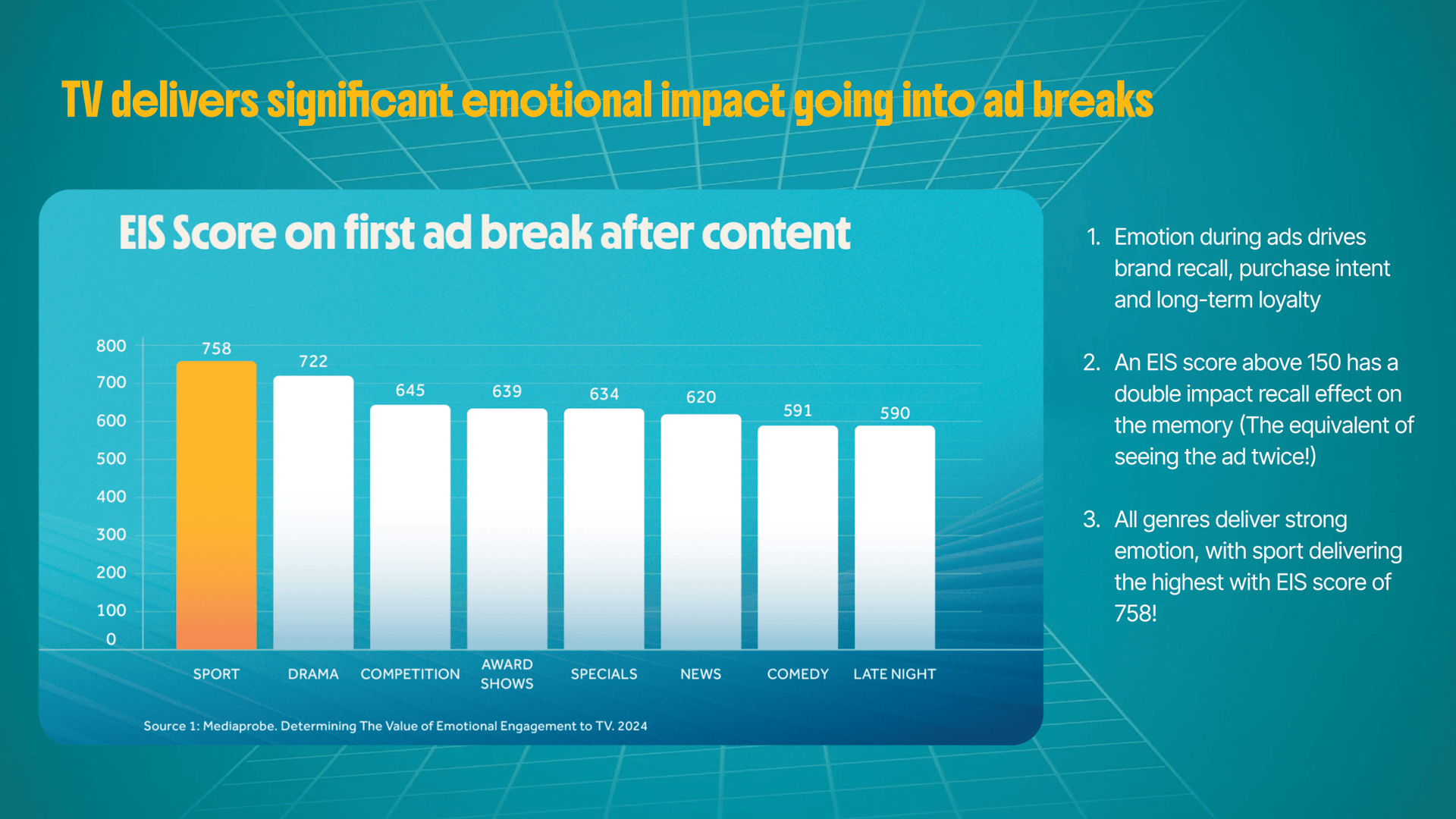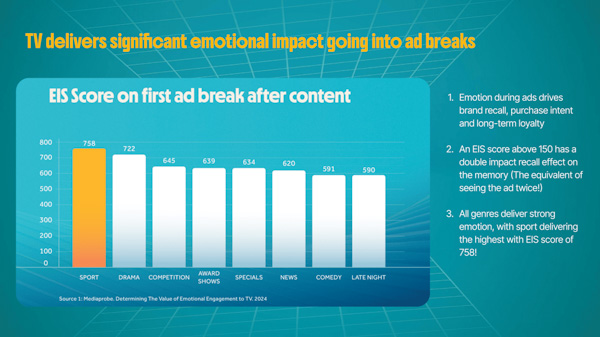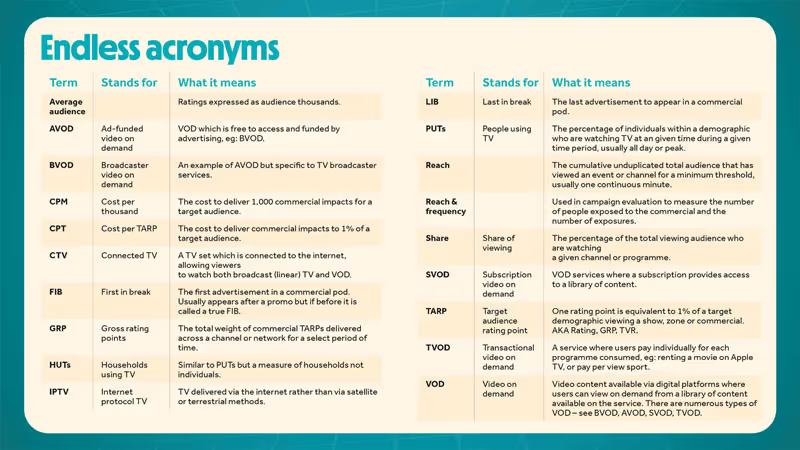Why Emotion Matters: The Case for TV at the Heart of Creative Campaigns

We are strong advocates for the idea that great advertising needs a great vehicle - one that delivers both strong attention and strong emotion.

Why Emotion Matters: The Case for TV at the Heart of Creative Campaigns
We are strong advocates for the idea that great advertising needs a great vehicle - one that delivers both strong attention and strong emotion. The synergy of that combination lies at the very heart of a creative campaign’s commercial success.
‘Attention delivers impact, emotion is what makes it stick.’ – Anna Lloyd, Sky New Zealand
It is a powerful truth that marketers cannot ignore. Without attention, there is no engagement. Without engagement, there is no emotion. And without emotion, the ability of advertising to drive long-term commercial results collapses.
Ads that drive emotion are proven to deliver results
The evidence is consistent and compelling. When advertising evokes strong emotional responses, its effectiveness multiplies.
Short-term results
Research from Professor Karen Nelson-Field in Australia showed that TV ads triggering strong emotional reactions delivered a 2.4x greater short-term sales impact compared to low-emotion ads. These emotionally charged ads also captured 16% more attention than their less engaging counterparts.
In other words, attention and emotion combine to create a commercial multiplier effect. Emotion makes campaigns memorable, while attention ensures the message is absorbed.
Long-term results
The commercial dividends extend even further over time. According to System1’s Creative Dividend study, emotional campaigns deliver 33% incremental profit over three years. When emotion combines with fluency - campaigns that are easy to process and remember - that figure rises to 45%.
By contrast, non-emotional campaigns generated only 6% incremental profit over the same period. The difference is stark: emotion is the engine of long-term growth.
.jpg)
_1.jpg)
Why attention comes first
Of course, emotional storytelling does not happen in a vacuum. The creative has only seconds to capture attention and spike emotion. If the audience is not paying attention, the opportunity for an emotional response disappears.
To succeed, creative must appeal to the right hemisphere of the brain - through light, colour, sound, narrative and story-telling that drives human connection, surprise, and tension-and-release. But even the most artful ad cannot achieve this in seconds without first securing attention.
That is why marketers need platforms that deliver sustained attention and engagement, combined with the ability to heighten emotional states before an ad appears. This is where TV stands alone.
TV’s unique role in emotional priming
Other environments simply cannot match the emotional set-up that TV provides. Outdoor has limited time to engage, print cannot deliver dynamic multi-sensory storytelling, and radio cannot provide visual or narrative build.
TV, by contrast, offers the complete emotional canvas. A study comparing TV and YouTube found that TV ads produce greater attention and more positive emotional responses. This effect may not always be conscious, but it influences viewers at a subconscious level over time. Importantly, TV also activates the mirror neuron system and social cognition areas of the brain - meaning viewers experience emotions socially, not just individually.
Watching others enjoy, celebrate, or suffer on screen evokes communal emotions. These emotions carry directly into the advertising break, creating a primed audience ready to feel more deeply.
‘TV does not just provide an environment for emotional campaign delivery; it drives emotion itself.’
The emotional lift of TV content
The emotional contribution of TV programming itself is often overlooked. But recent research proves its importance.
Mediaprobes’ 2024 study measured the emotional impact score (EIS) of TV genres heading into ad breaks. Even the lowest genre, late-night talk shows, delivered an EIS of 590 - far above the 150 benchmark required for double impact recall. At the other extreme, sport reached 758 EIS, creating highly elevated emotional states before ads even appeared.
The implication is clear: brands do not need to take audiences from a neutral baseline to an emotional peak in 30 seconds. TV does much of the heavy lifting. By the time the ad appears, audiences are already in motion - and the creative only has to push them higher.

Excitation transfer: the science behind it
Psychological theory helps explain why TV is so effective at emotional priming. Zillmann’s Excitation Transfer Theory argues that emotional arousal from one stimulus can carry over and intensify responses to another. In plain terms: the excitement from a suspenseful drama or thrilling sports event bleeds into the way viewers respond to the next ad.
This residual arousal makes ads feel more emotionally intense, engaging, and memorable - even if viewers attribute that heightened feeling to the ad itself.
This is not speculation. It is measurable, physiological science. TV creates fertile ground for advertising by ensuring audiences are already emotionally charged when creative arrives.
Why other formats cannot compete
While OOH, radio, or digital video can capture moments of attention, they cannot consistently prime emotions in advance of creative delivery. Nor can they provide the immersive, multi-sensory experiences that TV offers.
OOH may deliver big scale, but with limited time and little ability to carry narrative or evoke strong feelings. Radio may offer reach, but it cannot provide the combination of visual, auditory, and social cues that TV integrates seamlessly. Even online video lacks the reliability and scale of TV’s emotional delivery.
This is why advertisers return to TV: it is the only medium capable of consistently fusing attention, emotion, and scale into a single delivery platform.
The marketer’s takeaway
For a truly successful creative campaign that drives recall, profit, brand uplift and memorability, two ingredients are essential:
- Attention to engage.
- Emotion to make it stick.
‘Only TV can deliver attention and emotion together, consistently and at scale.’
In a fragmented world of fleeting attention and distracted audiences, TV remains the unrivalled platform where creative work can thrive, build memory structures, and drive both short-term sales and long-term growth.
Marketers face endless choices, but the evidence is unequivocal. Emotion drives effectiveness. Attention makes emotion possible. And TV is the medium where the two converge.
If commercial success depends on making audiences care, then TV must sit at the heart of every serious creative strategy.
Sources
- ThinkTV Australia – Emotional Ads Study: Karen Nelson-Field’s research showing TV ads that trigger strong emotions deliver 2.4x sales impact and 16% more attention.
- System1 – The Creative Dividend: Findings that emotional campaigns drive 33% more profit over 3 years, rising to 45% when combined with fluency.
- System1 Group – The Triple Opportunity of Attention (2022): Evidence on how creative needs right-brain engagement (light, colour, sound, story) to drive emotion.
- PubMed Central – TV and Emotional Engagement: Study comparing TV and YouTube showing TV delivers greater attention, more positive emotional responses, and activates social cognition areas in the brain.
- MXM India – The Psychology of TV Advertising: Commentary on why TV ads engage us differently and create communal emotional experiences.
- Mediaprobe – Emotional Measurement Study, 2024: Findings that TV genres prime audiences emotionally before ad breaks, with EIS scores from 590–758.
- Zillmann, D. (1983), Journal of Personality and Social Psychology: Excitation Transfer Theory explaining how arousal from one stimulus intensifies responses to another.


_1.jpg)
.jpg)



